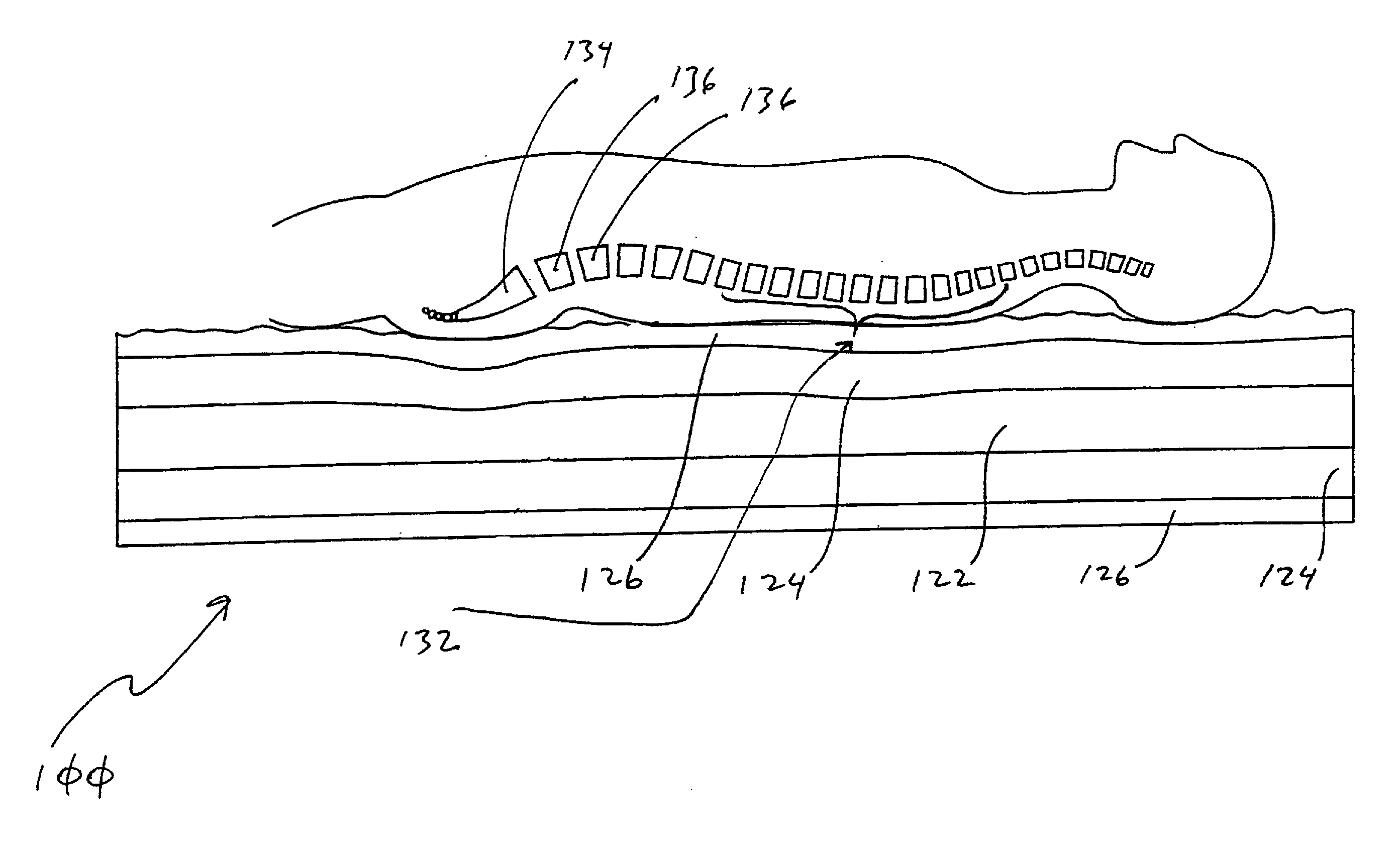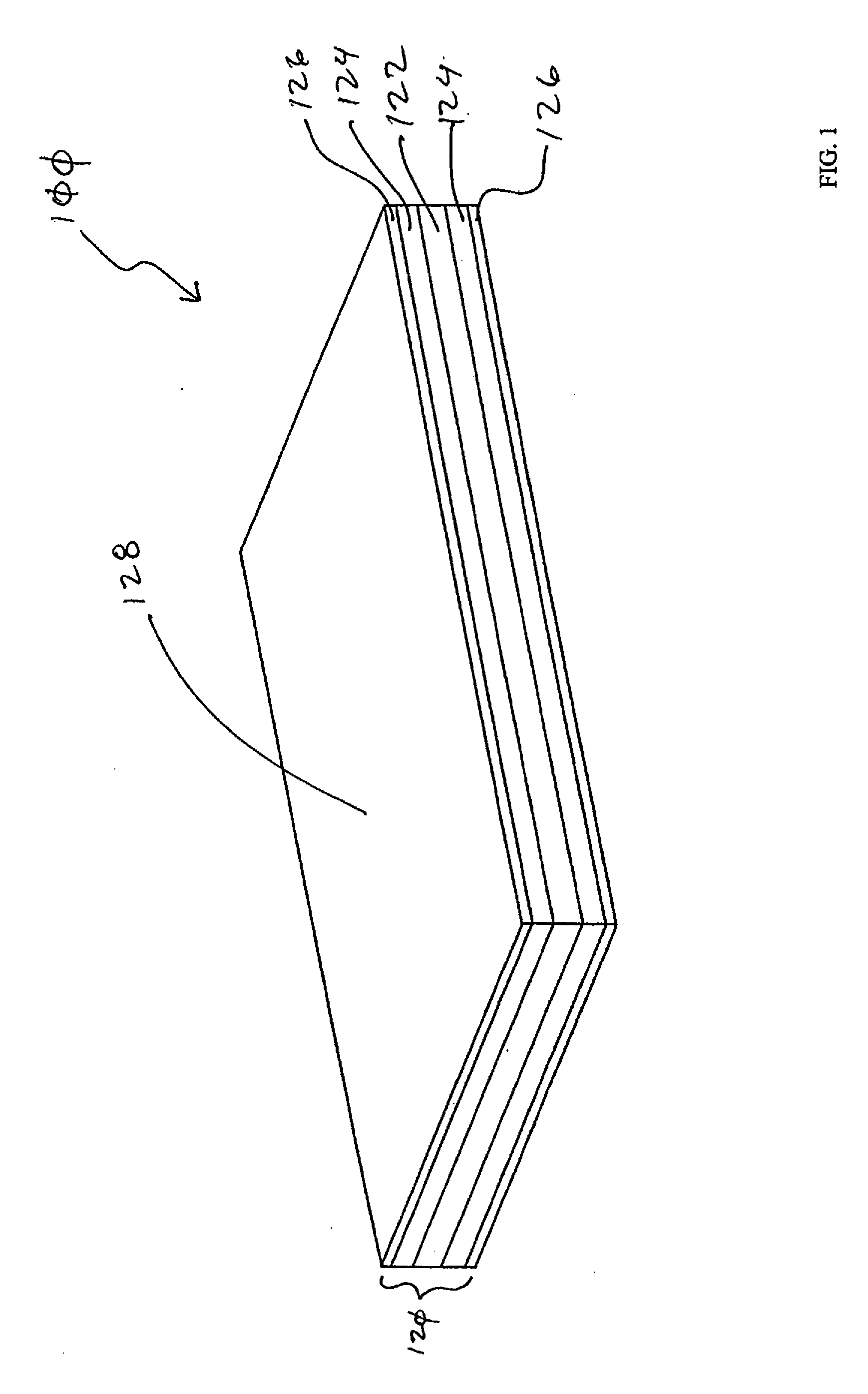[0007]The invention prevents lumbosacral
hyperextension and thoracic hyperflexion in a supine user by offering multiple
layers of selected IFD foam. The IFD of the foam
layers selected in accordance with the invention reduces nerve and
muscle tension and pressure by preventing excessive mattress-sag-induced spinal
facet imbrication and foraminal narrowing.
[0008]An example embodiment of the invention comprises a multi-layered, multi-density and multi-IFD body support apparatus that takes into consideration the physical properties of foam as defined by the PFA's IFD measurement parameters. Comfort is achieved by providing an outer layer of foam with low IFD closest to the user's
skin and fat layer. This minimizes or prevents pressure points that could be uncomfortable or dangerous. The invention also takes into consideration the physical properties of foam as defined by the PFA's IFD measurement parameters to achieve support and comfort for the user's
muscle tissue layer by providing foam with medium IFDs. This minimizes or prevents pressure points while providing a soft yet supportive layer similar to that of relaxed
muscle tissue. In addition, the present invention takes into consideration the physical properties of foam as defined by the PFA's IFD measurement parameters to achieve support in the middle or base layer of foam to reduce or prevent excessive mattress sag that could lead to or cause lumbopelvic
hyperextension and associated disc
distortion,
facet imbrication and foraminal narrowing. The middle or base layer of foam has an IFD selected to provide support to the user's spinal joints and can help prevent or reduce uncomfortable or dangerous sag of the internal spinal
layers of the
human body.
[0009]The present invention is an efficient and cost effective, non-mechanized device that meets the aforementioned needs for support and comfort by incorporating an established measurement
system of Indention Force Deflection that mathematically assesses the
physical performance characteristics of foam wherein the support that a selected foam will provide can be calculated into
pounds per square inch. From these
pounds per square inch ratings compression, deflection or support can be accurately assessed and predicted. The present invention includes layers of foam specifically chosen with IFDs, densities, layers and thickness of layers to create a mattress or Tension and Pressure Relieving Body Support Apparatus that provides comfort and support where spinal posture is maintained where spinal levels have relatively normal disc spacing, foraminal spacing and
facet alignment. Although other factors such as spinal
scoliosis, spinal compression fracture, severe vertebral subluxation and
degenerative arthritis can have negative affects on disc spacing, foraminal spacing and facet alignment. The present invention with its selected IFD, density and
layer thickness tends to reduce the negative affects of lumbosacral
hyperextension. The present invention provides superior tension and pressure relief to the spine and other regions of the back.
[0010]Specifically, the Body Support Apparatus provides the spinal support that is necessary for spinal rest and optimal clearance for vascular and neural structures by reducing mattress sag-induced lumbosacral hyperextension at lumbosacral levels and thoracic hyperflexion. Improved sleep posture in turn leads to greater levels of comfort, deeper levels of sleep and spinal rest.
[0011]Pressure and tension relief is substantially uniform along the surface of the mattress or body support apparatus due to the invention's contiguous design that minimizes the existence of zones of diminished pressure or tension relief as seen in prior art mattress products that have IFDs too high or low to provide substantially uniform support to the spine. An example embodiment of the invention includes a core layer of high IFD foam, an intermediate layer of medium IFD foam, and an outer layer of low IFD foam bonded together to provide continuous and contiguous support. In different embodiments, the present invention can have between two to seven layers of foam with selected IFD, density and
layer thickness. By having multiple layers of foam with the described IFDs, densities and thicknesses, the present invention may be able to facilitate the ability of the
nervous system to better achieve the rest phase during sleep, promote circulation of the blood to the spine and reduce tension and pressure in the spine and muscles.
[0012]Regardless of the materials used in the construction of a mattress, sag can be avoided if layers of the mattress have appropriate indention force deflection to
resist the heaviest centers of gravity of the
human body at or near the
sacrum and at or near the center of the
thoracic spine. These areas near the
sacrum exert approximately 0.5-1.5
pounds per square inch of pressure on a surface beneath the body. The areas near the center of the
thoracic spine exert approximately 0.3-1.3 pounds per square inch.
 Login to View More
Login to View More 


